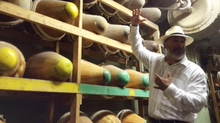Wanted: Workforce for 'The City That Makes Things'
A stubborn stereotype of Chicago is that it doesn’t make things anymore. It does.
Among economic sectors, manufacturing remains one of the Chicago region’s biggest employers, with a workforce of more than 363,000 in 2017. Between April 2017 and March 2018, manufacturing yielded more than 58,000 job postings, according to a new study by the Century Foundation and the University of Illinois at Chicago’s Great Cities Institute. That outpaced more than a dozen other sectors, including retail, transportation/warehousing and education.
Yes, the steel mills are gone, but “The City That Works” is still “The City That Makes.”
There’s something wrong with this picture, however. Last year in the Chicago area, there were two job openings for every hire, according to the study. At least 16,000 unfilled job openings involved work that required only a high school education. The jobs are there, but there aren’t enough qualified workers to fill them.

An employee performs quality control inspections of the liquid soaps that are produced and bottled at the Method Soap factory at 750 E. 111th in Chicago on March 25, 2015. (Antonio Perez / Chicago Tribune)
But guess what — the labor pool is there. In 2016, unemployment among African-Americans in Cook County stood at 15.5 percent, and 7.3 percent among Hispanics. The key, then, is to prepare those young people for jobs in manufacturing.
At City Colleges of Chicago, apprenticeships have become a conduit for labor that’s tailored to local industries. Modeled after the German approach, local corporations help design the curriculum for City Colleges’ apprenticeships. Each college has its own specialty. At Richard J. Daley College, that niche is advanced manufacturing. (Fitting, given that Mayor Daley the Elder often is credited with the nickname “The City That Works.”)
Mayor Rahm Emanuel recently doubled down on the program, announcing an initiative that allows the city’s high school juniors and seniors to enroll in short-term career programs at City Colleges without paying a dime.
Elsewhere in the state, apprenticeship programs have taken root. Last summer, the Illinois Department of Commerce and Opportunity revved up a pilot program to train 300 young people ages 16 to 24 in manufacturing, health care, information technology and construction.
Yet many jobs remain unfilled. Manufacturers, union leaders and workforce development leaders met at a recent summit at UIC to talk about how to close that gap, the Tribune’s Alexia Elejalde-Ruiz reports. Among the challenges: Many CPS high school graduates don’t have the basic math skills needed for jobs in manufacturing; many potential workers live far from the manufacturing job sites; and some youths are unaware of the manufacturing job opportunities that exist.
The need for manufacturing jobs in the region is only going to grow. Nearly 1 in 3 workers is over 55, according to the Century Foundation study. “People need to look at manufacturing as a growth opportunity and a growth sector,” says Andrew Stettner, a senior fellow at the foundation. “There was a view that this was a sector of the past, and no — it’s a sector of the future.”
A bigger, better trained labor pool is more likely to keep companies here, and more likely to attract manufacturers from out of state. In turn, those companies, and the jobs they bring, can serve as a lifeline for youths mired in a world of drugs and violence in Chicago’s broken neighborhoods.
We remember what one youth told the Great Cities Institute for a youth joblessness report the group had published last year: “Everyone wants drugs and violence to stop. Well then … get us off the streets and get us into some work clothes, and you will see the change.”
That’s a call to action that leaders in metropolitan Chicago should heed.





















